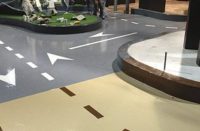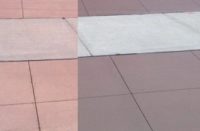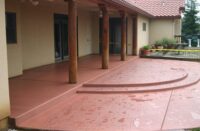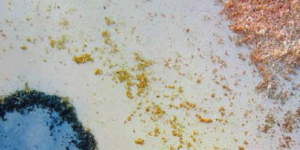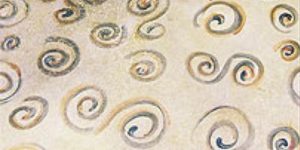There are unlimited opportunities to create fabulous effects with reactive acid stains. Acid stains are most mutable from the time they are sprayed onto the concrete until the reactive color change develops. During this reactive period, the greatest opportunity for color manipulation is while the stains are wet. Whether or not the stain stays wet on the surface throughout the entire reactive stage depends on the ratio of stain volume to surface porosity, as well as ambient factors such as temperature, humidity and air movement. The stain colors may continue to develop after the concrete is surface-dry. The wetter the stain-to-surface ratio, the greater the color reaction. Volume equals depth of color. This basic premise explains why, in a finished product, we may see puddles from heavy spray or “white” spots from surface porosity.
Let’s explore a few of the infinite opportunities available with stain colors.
Layering colors
When more than one stain color or concentration is sprayed simultaneously or wet-to-wet, the various chemicals compete for dominance. This application of various colors from multiple sprayers results in areas where each stain color develops or new colors blend from the convergence. If the various colors were all poured together and sprayed from a single sprayer, the outcome would simply be one color with the typical multitonal effect.
Similarly, spraying water during the application stage changes the color concentration with a phantom effect.
Take notice of the volume of stain applied with these advanced techniques, as product management can get tricky. You do not want the stain flowing through or under the floor plate and onto flooring not intended for stain.
Multiple colors
 The stains may also be sprayed wet-to-dry. This technique produces variant color, but with somewhat less organic movement and color blending. Most applicators apply lighter colors first, then darker. However, applying lighter colors after darker creates surprisingly nice effects. Greens, tans and blues have striking impacts on black stain. (One of my favorite ways to correct a problem area such as a drip of stain or an area that’s too dark is to carefully apply a tan stain on the drip. This will usually soften the spot and often eliminate the problem altogether. Of course, I test an inconspicuous area first.)
The stains may also be sprayed wet-to-dry. This technique produces variant color, but with somewhat less organic movement and color blending. Most applicators apply lighter colors first, then darker. However, applying lighter colors after darker creates surprisingly nice effects. Greens, tans and blues have striking impacts on black stain. (One of my favorite ways to correct a problem area such as a drip of stain or an area that’s too dark is to carefully apply a tan stain on the drip. This will usually soften the spot and often eliminate the problem altogether. Of course, I test an inconspicuous area first.)
Color manipulation
Scattering dry products onto the floor prior to the application of stains creates opportunity for color or pattern play as well. We all know about the wonders of Miracle-Gro fertilizer, but I also love using coffee. Dry-ground coffee (caffeinated or not) often produces small black specks in the stain. Instant coffee is even more interesting. The dehydrated concentration immediately begins to dissolve upon stain contact by sprouting “legs.”
When working with Miracle-Gro, I apply my stain in my normal “wet short of puddles” method until I reach an accumulation or slight mound. There, I apply a greater volume of stain with enough pressure to literally pick up the dry Miracle-Gro and suspend it in the stain just a bit. As the stain moves the dissolving product, it creates a wonderful organic effect. Staining over absorbent materials such as sawdust or cereal results in either a resist effect (where the stain color is lighter or not at all) or a concentration of color.
You can achieve the opposite outcome with the same material depending on the stain volume and the absorbent-material ratio.
If the stain is applied lightly enough that the material absorbs the stain but the concrete does not get wet, no color develops. However, saturating the material may cause the concrete color to develop further, if it remains wet on the concrete longer than the balance of the floor.
Resist
Resists provide amazing artistic opportunities with controlled outcomes. Various types of resist include gel resists such as LesCoat or laser-cut stencils.
During the wet stage, the stains are impacted by external factors as well. For example, anything that causes the stains to move, if stain volume allows, produces pattern. Blowing compressed air at varying pressures is interesting. Spreading thin sheets of plastic over the wet stain creates unique pressure points and temporary vapor retardation, resulting in stain pattern variance.
www.concretestaindesigns.com
